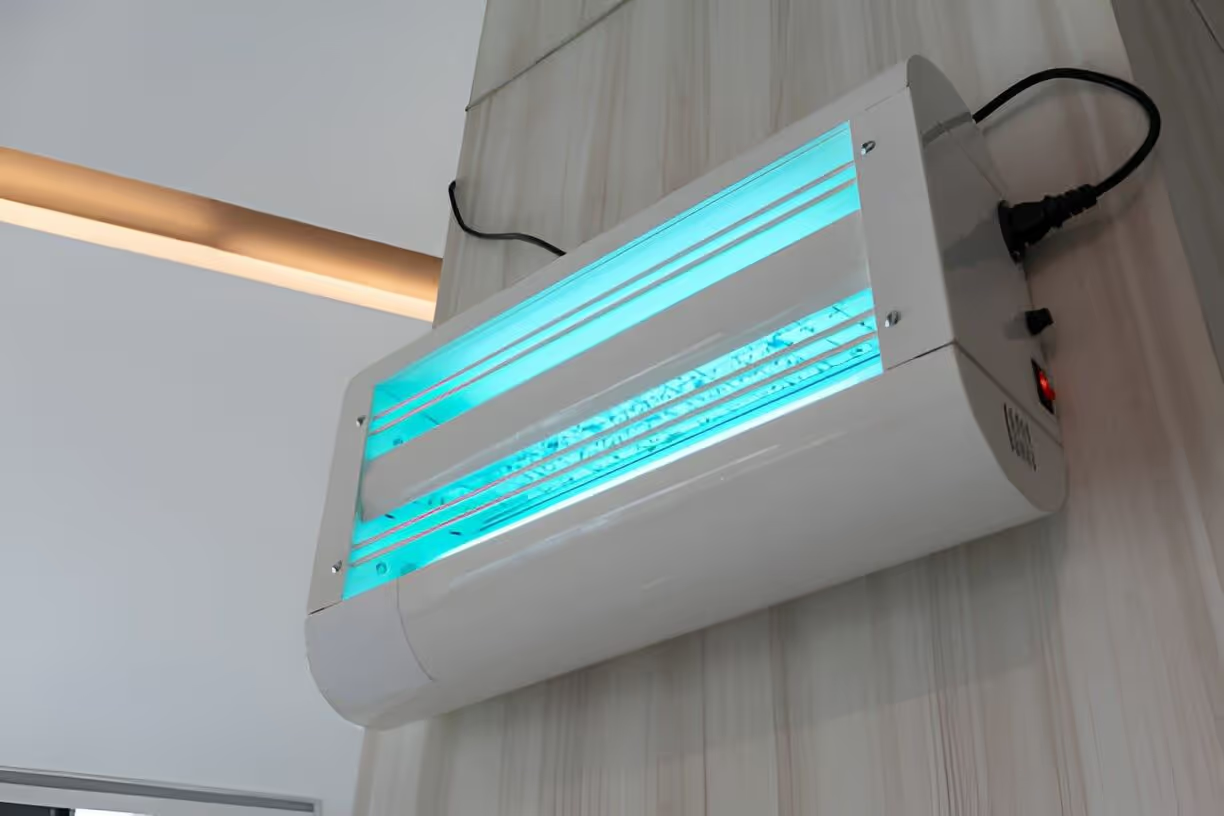UV Light in Plant City, FL


How UV HVAC systems work and the benefits for Plant City homes
- UV coil purifiers target the evaporator coil and drain pan where moisture and organic buildup collect. UV-C light breaks down microbial cell walls and prevents biofilm formation, keeping coils cleaner and restoring proper heat transfer.
- In-duct UV air purifiers place UV lamps inside the airstream to inactivate airborne microbes as the air passes through the ducts. This reduces circulating mold spores, bacteria, and some viruses.
Benefits specific to Plant City:
- Reduced mold and musty odors in a humid climate where coil contamination is common.
- Improved indoor air quality (IAQ) during heavy pollen seasons and agricultural spray periods.
- Better HVAC efficiency: cleaner coils and fewer biological blockages help systems cool more effectively and may reduce runtime.
- Health improvements: fewer airborne microbes and fewer allergens can ease symptoms for allergy and asthma sufferers.
Types of UV products offered
- Single-lamp coil purifiers: Mounted near the evaporator coil to continuously irradiate coil surfaces and drain pans.
- Dual-lamp coil systems: Provide broader coverage for larger coils or commercial systems.
- In-duct UV systems: Installed inside supply or return ducts to disinfect moving air.
- Upper-room or supplemental units: For specific problem rooms where duct access is limited.
- LED UV alternatives: Emerging technology with longer service life and no mercury; best for select applications today.
Each product is selected based on system size, coil geometry, duct layout, and household IAQ goals.
Professional installation and compatibility checks
A professional HVAC assessment ensures the right UV solution and safe installation:
- Inspect the HVAC system layout, coil access, and ductwork.
- Verify electrical availability and proper mounting locations.
- Determine lamp orientation and shielding to avoid direct exposure to occupants when servicing.
- Confirm system compatibility with warranty and manufacturer guidelines.
Technicians will size lamp output to the coil surface or duct flow rate and position lamps to maximize exposure time. Installation also includes checking ballast components, securing wiring, and documenting lamp placement for future maintenance.
Routine maintenance and replacement schedules
- Bulb replacement: UV-C lamps produce their rated output most effectively for a finite period. Most low-pressure germicidal lamps are replaced about once per year to maintain intensity; some LED options last several years.
- Quartz sleeve cleaning: Dust and residue can reduce UV transmission. Technicians typically clean sleeves during annual maintenance.
- Ballast and power checks: Ensure ballasts and wiring supply consistent current for optimal lamp performance.
- Verification: Periodic intensity checks with a UV radiometer confirm effective output.
A routine maintenance plan helps maintain IAQ benefits and protects manufacturer warranties.
Safety considerations
- UV-C light can damage skin and eyes with direct exposure. Proper installation places lamps inside the unit or ductwork so occupants are not exposed during normal operation.
- Installations include secure mounting, access interlocks, and service-labeling to prevent accidental exposure during maintenance.
- Choose ozone-free UV lamps for indoor use; certified germicidal lamps used for HVAC applications are designed to not produce harmful ozone when used correctly.
- Technicians follow safety protocols and provide documentation on safe servicing procedures.
Testing, measurement, and before-and-after verification
To quantify benefits, consider professional IAQ testing options:
- Surface and coil swabs or microbial cultures to show reductions in biological load.
- Particle counts and airborne spore counts before and after installation.
- ATP (adenosine triphosphate) testing to measure organic contamination on coils or drain pans.
- VOC and odor assessments to document reductions in musty smells.
- System performance checks (temperature split, airflow, and energy usage) to demonstrate efficiency improvements related to cleaner coils.
Documented testing provides objective evidence of IAQ improvement and system performance gains.
Warranty and expected system lifespan
- Manufacturer warranties typically cover lamp housings and electrical components for a set period; bulbs often carry limited warranties or are considered consumables.
- Proper installation and adherence to recommended maintenance schedules are generally required to keep warranties valid.
- High-quality UV systems and routine upkeep can provide many years of effective service; LED-based systems may offer longer lifespans and reduced replacement frequency.
Financing availability and budget considerations
Financing options may be available to spread the cost of HVAC improvements and whole-home IAQ upgrades. Because system needs vary by home size, HVAC configuration, and IAQ goals, a professional assessment will outline the recommended solution and financing choices suitable for individual circumstances.
Common FAQs for Plant City residents
- Q: Will a UV light remove dust and pollen?
A: UV systems target biological contaminants (mold, bacteria, viruses). They do not filter dust or large pollen particles; pairing UV with proper filtration (MERV or HEPA where compatible) gives broader IAQ benefits. - Q: Are UV lights safe for families and pets?
A: When installed correctly inside coils or ducts, UV-C is safe for occupants. Service access panels should be labeled and technicians should follow safety protocols. - Q: How quickly will I see results?
A: Odor and visible mold on coils often improve within weeks. Measurable reductions in airborne microbes can be seen soon after installation and with documented testing. - Q: Do UV lights save energy?
A: By keeping coils clean and preventing biofilm, UV lights can help restore heat transfer efficiency and reduce run-time. Energy savings depend on system condition and usage patterns. - Q: Do they prevent COVID-19 or other viruses?
A: UV-C can inactivate many viruses in laboratory settings. In-duct and coil UV systems reduce airborne microbial load as part of a broader IAQ strategy but are not a standalone guarantee against specific illnesses.
Installing a UV light system is a practical step for Plant City homes dealing with humidity-driven mold, seasonal pollen, and the need for cleaner indoor air. Proper system selection, professional installation, routine maintenance, and documented testing ensure the best outcomes for health, comfort, and HVAC performance.
Service Areas


